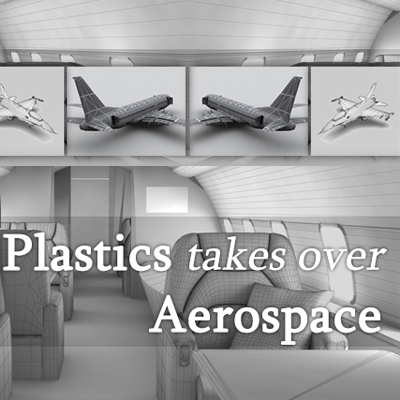Plastics Takes Over Aerospace in a Right Way

Throughout the latter half of the 20th century and much continuing in the new century, aeronautical engineering has evolved in leaps and bounds, with plastics assuming a real part in both practical upgrades and striking advances. Plastics components have been the smooth and significant development contributors in the world of civil aviation, military aircrafts and missiles, satellites, space shuttles, and space exploration.
Try to recollect images of astronauts standing on the beautiful surface of the moon – the strong and durable transparent visors embedded in helmets. Both were made of molded plastic, best suited for the job!
Boeing’s 787 Dreamliner which was usually known as the ‘plastic airliner’, has a fuselage that is made up og a new generation of reinforced composite plastic panels. Now the usage of plastics in a Boeing gives it the same kind of benefits that it does give to an ideal combination of strength, design, flexibility, manufacture ease: all with its light weight.
With World War II, plastics began to make a noticeable entry into aerospace. Plastics fit the bill because of its easy availability, ease of design and manufacture and most importantly the many possible applications of plastics. Vinyl materials began to gain popularity to be used to line fuel tanks and fliers’ boots. Plastics used in randomes that cover radars are transparent to electromagnetic waves. This helped in increasing transmission and thus significantly developed the nascent radar technical capacity. Plastic materials are flexible so much so that it can withstand the helicopter vibrations and at the same time ensure safety. They can be made transparent for an easy observation, made shatter resistant and even made to provide ballistic protection. The remarkable efficiency of plastics was witnessed in the 1970s when the oil crisis forced the aerospace companies to develop fuel efficient aircrafts.
It is known that the heavier the vehicle more is its need for fuel to travel a specific distance.
“The weight-to-fuel impact for jetliners is extreme. A one-pound weight reduction will mean tens and even hundreds of thousands of dollars in lifetime fuel savings, and plastic composites in the Boeing 787 reduced the total plane weight by about 20 percent, or thousands of pounds” - plasticsindustry.org
Another advantage of plastics is that its smooth contour providing capacity makes it an ideal choice for aerodynamics: saves fuel as well as money. It is also easy to repair plastic manufactured aircrafts because of its light weight.
Stealth tactics are indispensable in the military sphere. Few plastics materials can provide invisibility to the radar, infrared and other mechanisms that spot an unknown flying object – perfect for stealth operations. The 21st century will see an upsurge in the usage of plastics. After Boeing, most commercial airliners are trying to implement the usage of reinforced composite plastics. Defence sector will keep trying to use plastics for a stronger alternative that makes aircrafts light and difficult to detect.
For sure, plastics can help mankind in space, when we eventually get to live there.
Source:plasticsindustry.org



